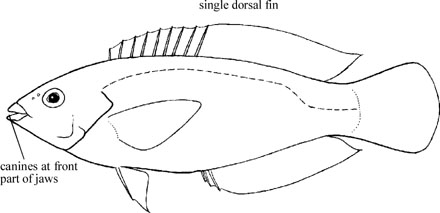LABRIDAE
Wrasses
By Ukkrit Satapoomin
 Halichoeres bicolor |
|
|
A diverse group of fishes varying in body shape and size (usually below 20 cm); body slightly to extremely compressed. Mouth terminal, slightly to extremely protrusible, usually with prominent lips; maxilla not exposed on cheek; teeth in jaws usually separate and caniniform, the anteriormost 1 or 2 pairs typically enlarged and often directed forward; pharyngeal jaws strong with pharyngeal teeth either sharp, conical, or broad and molariform. A single, long-base dorsal fin in most species, with VIII - XXI spines (usually less than XV) and 6 - 21 soft rays; anal fin with II - VI spines (often III) and 7 - 18 soft rays. Scales cycloid and highly variable in size among species; head never fuly scaly; lateral line interrupted or continuous. Color: most species with bright and intricate color patterns, including stripes, bars, spots, blotches, and ocelli. Most species change color and sex with growth, from an initial phase (IP) of females, the latter able to change sex into an often brilliantly colored terminal male phase (TP).
Similar families occurring in the area. Scaridae: mouth not protrusible; teeth in jaws coalesced at base or fused into a bony, parrot-like beak, except a few species; lips continuous with facial skin, without an indentation. Remarks. Most common in shallow waters in a variety of habitats such as coral reefs, rocky reefs, sand, seagrass, and algae, but rarely found in muddy areas. Wrasses are diurnal with diverse feeding habits, including benthic invertebrates, fishes, coral mucus, zooplankton, ectoparasites, and algae. The family name derived from Latin, labrum = furious. |

|
|